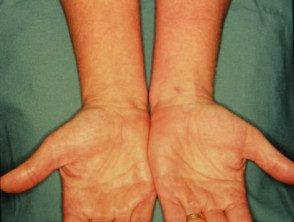What is aquagenic? urticaria?
Aquagenic urticaria is a rare variant of chronic inducible urticaria that occurs in response to contact with water [1,2].
Aquagenic urticaria

Aquagenic urticaria
Who gets aquagenic urticaria?
Less than 50 cases of aqugenic urticaria have been reported in the medical literature. [2]. There is a greater predominance among women, with the typical age of onset during or after puberty [3]. Most cases have occurred sporadically, but several family Cases have also been reported [3].
What Causes Aquagenic Urticaria?
The exact Pathogenesis of aqugenic urticaria is poorly understood.
Water reacts with unknown components within the skin, causing histamine release from mast cells and the formation of a urticarial eruption. Triggers can include:
- Still or running water
- Seawater
- Sweat and tears [1].
Aquagenic urticaria arises regardless of the temperature of the water or its pH and it is not dependent on psychogenic factors [4].
What are the clinical features of aquagenic urticaria?
Skin contact with water produces symptoms in 20-30 minutes.
- 1–3 mm folliculocentric cure surrounded by 1–3 cm erythematous flares are characteristic [1].
- The rash mainly affects the trunk and upper arms, with palms and soles often preserved. [1,2,5].
- The eruption can spread to involve areas that are not in contact with water.
- Scars normally resolve spontaneously within 30 to 60 minutes of cessation contact with water [1].
- Associated symptoms include pruritus, burning and itching [2].
In rare cases, the patient may also experience systemic symptoms of wheezing and shortness of breath [1].
What are the complications of aquagenic urticaria?
Intense or prolonged itching causes excoriations which can become secondarily infected and begin to ulcerate and scar.
Patients with aqugenic urticaria may experience psychological stress due to fear of water.
How is aquagenic urticaria diagnosed?
A medical history of urticaria in response to exposure to water is suspicious for aquagenic urticaria, but the diagnosis must be confirmed by a positive water challenge test and the exclusion of other types of inducible chronic urticaria.
Water provocation test
A water challenge test can be performed to detect aquatic urticaria using the following method:
- Apply room temperature water to a cloth
- Apply the damp cloth to the patient's skin for 30 minutes.
- Assess the skin for a urticarial reaction [1–3.5].
To exclude cholinergic urticaria, an exercise test can be performed with the intention of raising core body temperature and observing the urticaria [6].
Which is the differential diagnosis for aquagenic urticaria?
Aquagenic urticaria must be distinguished from other forms of inducible urticaria, including [1]:
- Salt-dependent aquatic urticaria: sea water causes lesions but not fresh water
- Aqugenic itching: exposure to water causes itching, but without associated skin lesions
-
Dermographism: common physical urticaria with linear cure
-
Cholinergic urticaria: scars are morphologically similar to those of aqugenic urticaria, but arises with an increase in core body temperature rather than exposure to water
-
Cold urticaria: cold contact produces pruritus Riches and sprouts
-
Delayed pressure urticaria: itching, swelling, and pain 4–8 hours after the skin is exposed to pressure
- Induced by exercise anaphylaxis
- Local heat urticaria: limited to area of heat exposure
-
Solar urticaria: an immediate reaction to Ultraviolet radiation that is resolved in 24 hours
- Vibratory angioedema – erythema and angioedema beyond the provocation site.
What is the treatment for aquagenic urticaria?
Since it is impossible to avoid water completely, treatment aims to alleviate symptoms induced by contact with water.
The main treatment is a non-sedating second-generation H1 antihistamine, such as cetirizine, loratadine, or fexofenadine. [4].
Other reported treatments include:
- First generation H1 antihistamines
- H2 antihistamines
- Acetylcholine antagonists, such as scopolamine
- Phototherapy
-
Omalizumab [5]
- Emollient [7].
What is the result of aquagenic urticaria?
The rate of remission of aquagenic urticaria is unknown.

